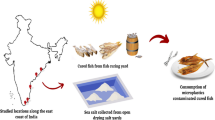Abstract
The correlations among the contents of trace elements in the shells of short-neck clams collected from Japan, China, and the Republic of Korea were examined. Origin-specific elemental content patterns were seen in clams originating from Japan, China, and the Republic of Korea. The crushed shells were decomposed with nitric acid–hydrogen peroxide, and the concentrations of ten elements (Li, V, Mn, Co, As, Rb, Mo, Ba, Pb, and U) in the shells were measured by inductively coupled plasma mass spectrometry. Some of the metal concentrations in the samples displayed clear geographical trends. The average concentration of Pb in Japanese clam shells was one-half to one-quarter that seen in Chinese or Korean clams. Average concentrations of As, Rb, and Ba in shells of Japanese origin were one-half those observed in Chinese or Korean clams. Linear discriminant analysis was applied to these analytical data, and four discriminant models were constructed. These discriminant models were able to distinguish the geographic origins of short-neck clams with 80.0–100 % accuracy. In particular, clams of Japanese origin were classified correctly ≥90 % of the time. Therefore, the trace elemental analysis of a short-neck clam shell is useful for identifying the country of origin of the clam.

Similar content being viewed by others
References
The Ministry of Agriculture, Forestry and Fisheries of Japan (MAFF) (2011) Statistical yearbook of ministry of agriculture, forestry and fisheries. MAFF, Tokyo
The Ministry of Finance of Japan (MOF) (2011) Trade statistics of Japan. MOF, Tokyo
Ariyama K, Aoyama Y, Mochizuki A, Homura Y, Kadokura M, Yasui A (2007) Determination of the geographic origin of onions between three main production areas in Japan and other countries by mineral composition. J Agric Food Chem 55:347–354
Kadokura M, Homura Y, Watanabe H, Horita H, Suzuki T, Yasui A (2010) Technique for checking the geographic origin of pumpkin by inorganic element composition (in Japanese with English abstract). Nippon Shokuhin Kagaku Kaishi 57:78–84
Rooker JR, Secor DH, Zdanowicz VS, Metrio GD, Relini LO (2003) Identification of Atlantic bluefin tuna (Thunnus thynnus) stocks from putative nurseries using otolith chemistry. Fish Oceanogr 12:75–84
Yamashita Y, Omura Y, Okazaki E (2006) Distinct regional profiles of trace element content in muscle of Japanese eel Anguilla japonica from Japan, Taiwan, and China. Fish Sci 72:1109–1113
Smith RG, Watts CA (2009) Determination of the country of origin of farm-raised shrimp (family Penaeide) using trace metal profiling and multivariate statistics. J Agric Food Chem 57:8244–8249
Morohashi T, Aoyama K, Namikoshi A, Kimura Y, Hattori S (2011) Determination of the geographic origin of boiled and salted wakame Undaria pinnatifida products by element analysis (in Japanese with English abstract). Nippon Suisan Gakkaishi 77:243–245
Iguchi J, Yamashita Y, Touhata K, Yabu T, Yamashita M (2013) Origin identification method by multiple trace elemental analysis of intermuscular bones in grilled eel products produced in Japan, China, and Taiwan. Fish Sci 79:531–536
Steel RGD (1960) A rank sum test for comparing all pairs of treatments. Technometrics 2:197–207
Fisher RA (1936) The use of multiple measurements in taxonomic problems. Ann Eugen 7:179–188
Hamaguchi M, Okoshi K (2005) Biological impacts caused by release of imported clam, Ruditapes philippinarum. J Jpn Soc Water Environ 28:608–613
Hamaguchi M (2007) Development of discrimination methods of imported and native Manila clam, Ruditapes philippinarum. Res J Food Agric 30:38–41
Kraak MSH, Toussaint M, Lavy D, Davids C (1994) Short-term effects of metals on the filtration rate of the zebra mussel Dreissena polymorpha. Environ Pollut 84:139–143
Angelo RT, Cringan MS, Chamberlain DL, Stahl AJ, Haslouer SG, Goodrich CA (2007) Residual effects of lead and zinc mining on freshwater mussels in the Spring River basin (Kansas, Missouri, and Oklahoma, USA). Sci Total Environ 384:467–496
The National Institute of Advanced Industrial Science and Technology (2004) Geochemical map of Japan. Yatabe Printing, Tukuba, pp 14–18
Xuejing X, Binchuan Y (1993) Geochemical patterns from local to global. J Geochem Explor 47:109–129
Wang S, Jia Y, Wang S, Wang X, Wang H, Zhao Z, Liu B (2010) Fraction of heavy metals in shallow marine sediments from Jinzhou Bay, China. J Environ Sci 22:23–31
Acknowledgments
This study was supported by a project grant (Development of Evaluation and Management Methods for Supply of Safe, Reliable and Functional Food and Farm Produce) from the National Food Research Institute and the Ministry of Agriculture, Forestry and Fisheries of Japan. We thank Ms. T. Suzuki for technical assistance.
Author information
Authors and Affiliations
Corresponding author
Rights and permissions
About this article
Cite this article
Iguchi, J., Takashima, Y., Namikoshi, A. et al. Origin identification method by multiple trace elemental analysis of short-neck clams produced in Japan, China, and the Republic of Korea. Fish Sci 79, 977–982 (2013). https://doi.org/10.1007/s12562-013-0659-9
Received:
Accepted:
Published:
Issue Date:
DOI: https://doi.org/10.1007/s12562-013-0659-9




